|
|
|
|
|
|
|
|
|
|
|
|
| |
|
CITY
HOSPITAL
The
original Memphis General Hospital opening in 1829, was on
Union Avenue, and was owned by the State of Tennessee.
During the Civil War, it became a military hospital.
Afterwards, Tennessee gave ownership of the building to the
city of Memphis and the hospital was re-named "City Hospital".
In 1898 the "City Hospital" pictured in the postcards was
built on Madison Avenue and the old hospital building was
demolished. The grounds of that old building are now the
site of Forrest Park. |
| |
|
|
|
|
|
|
|
|
|
| |
| |
 |
 |
|
 |
|
City Hospital |
City
Hospital 1906 |
|
Class of 1901 |
|
| |
| |
| |
|
BAPTIST
MEMORIAL HOSPITAL
The
Baptist Memorial Hospital's origins date back to 1912 when the
Southern Baptist Conventions of Mississippi, Tennessee, and
Arkansas jointly opened Baptist Memorial Hospital in the
Madison Avenue Memphis Medical Center. On November 17, 2000, Baptist
transferred its last 14 patients to other facilities, marking
the closing of the 88 year old hospital. The buildings
were then demolished. The current Baptist Memorial
Hospital is a 706 bed medical facility located on Walnut Grove
Road. It was built in 1979 and is the flagship of
Baptist Memorial Healthcare. The former Madison Avenue
Medical Campus has been redeveloped by the University of
Tennessee Health Science Center. |
|
|
|
|
 |
 |
 |
 |
|
Original Baptist 1912 |
Baptist 1917 |
Tri-State Baptist 1917 |
Tri-State Baptist 1918 |
|
| |
| |
|
|
|
|
|
|
|
|
| |
|
|
| |
|
ST.
JOSEPH HOSPITAL
Saint Joseph Hospital was a Catholic-operated hospital at 220
Overton Avenue. It was here that Martin Luther King Jr.
was pronounced dead April 4, 1968. The hospital was
erected and operated by the Sisters of St. Francis in 1885.
It would eventually grow into a 1212 bed Medical Center.
In 1997 the hospital began a merger with Baptist Memorial
Health Care. The property and buildings were sold to St.
Jude Children's Research Hospital. All of them but one
were subsequently demolished to make room for St. Jude's
expansion. The St. Joseph-Baptist merger was completed
in 1998 and St. Joseph's last patients were transferred to
Baptist in November 2000. |
|
|
 |
 |
 |
 |
|
St. Joseph 1889
|
St. Joseph 1889 |
St. Joseph 1906 |
St. Joseph Aerial View |
|
| |
| |
 |
 |
 |
 |
|
St. Joseph 1912
|
St. Joseph 1912 |
St. Joseph 1906 |
St. Joseph Float |
|
|
|
| |
|
|
| |
| |
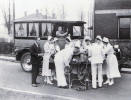 |
 |
 |
 |
| Ambulance 1925 |
St.
Joseph Chapel |
St.
Joseph - Vintage |
Operating Rm
1925 |
|
| |
 |
|
|
|
|
Parlor 1914
|
|
|
|
|
| |
|
|
| |
|
METHODIST
HOSPITAL
Founded in 1918 by John M. Sherard, the Methodist Hospital has
grown into Methodist Healthcare - the third largest
not-for-profit hospital in the nation. In 2000 Modern
Healthcare magazine ranked Methodist Health Care, Memphis, as
one of the top integrated healthcare networks in the nation,
and the Methodist Memphis Hospitals has been named the Best
Hospital in Memphis by U. S. News and World Report. The
hospital was cited as best in 12 medical specialties:
cancer, diabetes/endocrinology, ear/nose/throat,
gastroenterology, geriatrics, gynecology, heart and heart
surgery, kidney disorders, neurology and neurosurgery,
orthopedics, pulmonary and urology. |
| |
| |
 |
 |
 |
 |
|
Methodist site 1898
|
Methodist Opens 1921 |
Methodist |
Methodist |
|
| |
| |
 |
 |
 |
|
 |
|
Methodist 1946 |
Methodist - Doctor's
Bldg |
Pharmacy |
|
Methodist New Wing |
|
| |
| |
| |
|
MEMPHIS
MEDICAL SCHOOL
In
1911, five independent medical colleges located in Memphis
joined together and formed the Memphis Medical School, soon
becoming the University of Tennessee's College of Medicine.
Shortly thereafter, it becomes the largest in the U.S. |
| |
| |
 |
 |
 |
 |
|
Medical College 1907
|
Medical College |
Medical College |
Medical College PC 1911
|
|
| |
| |
 |
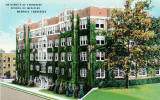 |
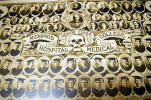 |
 |
| 1912 UT
College of Medicine |
UT School Medicine |
1908
Graduates |
UT
Medical College |
|
| |
| |
|
University
of
Tennessee Medical Centers
There are six graduate schools of the University of Tennessee
Health Science Center in downtown Memphis. It is the
oldest public medical school in Tennessee. The college's
primary focus is to provide practicing health professionals
for the state of Tennessee. |
 |
| |
UT -
College of Medicine |
|
|
|
|
| |
| |
|
JOHN
GASTON HOSPITAL
Before he died in 1912, John Gaston told his friends that
wanted his mansion converted into a public hospital.
That didn't happen until the death of his wife in 1929.
Then the mansion was deemed too small for a decent hospital
and it was demolished and the property was converted into
Gaston Park. The bulk of Gaston's fortune, supplemented
by funds from the Public Works Administration, was then used
to build a brand new city hospital in the Madison Avenue
Medical District. The John Gaston Hospital opened in
1936 and remained one of the city's busiest hospitals until it
was demolished in 1990 to make way for the growth of "The
Med". |
| |
| |
 |
 |
 |
 |
|
John Gaston 1936 |
John Gaston |
John Gaston 1947 |
Isolation Ward 1937
|
|
|
|
 |
 |
 |
 |
|
John Gaston Nurse Class
|
Gaston Maternity Ward
1970 |
Gaston Residents |
Implosion 1990 |
|
|
|
| |
| |
|
MILITARY
HOSPITALS |
| |
|
KENNEDY VA HOSPITAL
...
Built in 1943, Kennedy was a state-of-the-art medical
facility and one of the best equipped hospitals in the nation.
The hospital treated all types of casualties but specialized
in surgery, with an average of 30 operations a day.
There was a big center for the treatment of spinal cord
injuries and the second largest neuropsychiatry service in the
nation. Kennedy was like a city within a city with it's
own power station, fire department, housing for 2,000
personal, bowling alleys, movie theatre, recreation halls,
etc. Closed in 1967 ... now demolished. |
|
| |
|
VETERANS MEDICAL CENTER
...
is a fully accredited 244 bed facility located at 1030
Jefferson Avenue. More than 10,000 veterans receive
primary care and mental health services here. The center
offers acute medical and surgical care as well as intermediate
care. |
|
| |
|
MEMPHIS MARINE HOSPITAL
...
located at 360 Metal Museum Drive, was once part of the
federal health care system under President John Adams to
"provide for the relief and maintenance of disabled seamen".
The hospital opened in 1884 and the existing structures date
to 1936. The sprawling hospital sits on about 6 acres
high on a bluff directly across from DeSoto Park. After
decades of neglect the buildings have fallen into disrepair -
but there's a hidden treasure here. Two buildings from
the 1880s remain and both are on the National Register of
Historic Places. |
|
|
|
 |
 |
 |
 |
|
Veterans Bureau 1921
|
Kennedy Veterans Hosp
1943 |
Aerial-Kennedy 1950 |
Kennedy Veterans 1926 |
|
| |
 |
 |
 |
 |
|
Kennedy Ward B 1945
|
Tuberculosis
Hospital
on Rive |
Kennedy Christmas 1944 |
Veterans Hospital |
|
| |
| |
 |
 |
 |
 |
|
Marine Hospital 1880s |
Marine Hospital |
Marine Hospital 1904 |
Marine Hospital |
|
|
|
| |
|
|
|
ST. JUDE
HOSPITAL
St.
Jude Children's Research Hospital is the leading pediatric
treatment and research facility focused on Children's
catastrophic diseases. The institution was conceived and
built by the late entertainer Danny Thomas in 1962 as a
tribute to St. Jude Thaddeus, patron saint of impossible,
hopeless, and difficult causes. |
 |
|
|
|
 |
 |
 |
 |
|
St. Jude |
St. Jude |
St. Jude Marathon |
St. Jude |
|
| |
| |
| |
|
LE
BONHEUR CHILDREN'S HOSPITAL
848
Adams .
Founded in 1952, the Le Bonheur Children's Hospital offers
primary level 1 pediatric trauma care, as well as a nationally
recognized pediatric brain tumor program. It serves more
than 130,000 patients each year. It is ranked as one of
the nation's "Best Children's Hospitals". |
|
|
| |
 |
 |
 |
 |
 |
|
Ground Breaking
|
Construction 1951 |
Opening 1951 |
Entrance 1952 |
Le Bonheur Westside |
|
| |
| |
 |
|
|
 |
|
Child's Room
|
|
|
Le Bonheur 1978 |
|
| |
| |
| |
|
CRIPPLED
CHILDREN'S HOSPITAL
In
1917, ladies of the Calvary Episcopal Church went to Dr.
Campbell, at the Campbell Clinic, to inquire about purchasing
a wheelchair for a child. Instead, Dr. Campbell
encouraged them to establish a hospital. Two years later
the Crippled Children's Hospital opened and 35 patients were
admitted the first year. Throughout its sixty-three year
existence, the hospital and school cared for many hundreds of
children without any cost to their families. Sold to
Methodist Health Care in the 1970s. |
|
|
|
|
|
|
|
|
| |
| |
|
ST.
FRANCIS HOSPITAL
Since 1974 St. Francis Hospital has been a leading Medical
Center for Memphis. The 515 bed facility was the first
full-service hospital in East Memphis. It was the first
hospital to establish a Chest pain Emergency Center and the
first in Memphis to establish a Stroke Emergency Center. |
|
|
|
|
| |
|
|
 |
|
|
|
|
St. Francis |
|
|
|
| |
| |
|
SANITARIUMS |
|
|
|
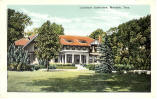 |
 |
 |
 |
 |
|
Lynnhurst |
Lynnhurst Ad 1922 |
Lynnhurst Sanitarium 1911 |
1904 Ad |
1905 Ad |
|
|
|
| |
 |
 |
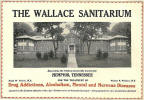 |
 |
 |
|
Wallace |
Wallace Ad
1922 |
Wallace 1920 |
Croffords |
1900 Ad |
|
| |
| |
 |
 |
 |
 |
|
1900 Ad |
James
Sanatorium |
James
Sanatorium 1911 |
James
Sanatorium 1910 |
|
| |
| |
| |
|
MISCELLANEOUS ... |
|
|
| |
|
Collins Chapel
Connections Hospital
Located at 416-18 Ashland Court. Collins Chapel was
a small, regional black hospital, which opened in 1910,
and had 75 beds. The hospital had an operating room,
a maternity ward, and a correctional ward. Dr. W. S..
Martin became superintendent in 1920.
|
 |
 |
 |
| |
Collins Chapel |
1915
Letter |
Advertisement |
|
| |
| |
 |
Mercy Hospital
. Located at 729 Mississippi Av. This was
another of the small, regional black hospitals. |
|
| |
| |
The Med
. The Regional Medical Center (The Med) was
chartered in 1829 and is the oldest hospital in Tennessee.
Funded by the Shelby County government, it is home to four
centers of excellence - High-Risk Obstetrics, Newborn,
Trauma, and Burn Centers. It also serves as an
educational and research resource for the University of
Tennessee at Memphis. |
|
| |
| |
 |
Eye, Ear,
Nose, Throat Hospital
. Dr. Louis Levy built this hospital in 1926 at
1060 Madison Avenue. It had one of the highest
ratings in the country but was plagued by a shortage of
funds. It was purchased by the Methodist Hospital in
1943. All patients were transferred to Methodist
Hospital in 1966, and the building was sold to a private
physician. |
|
| |
| |
|
Gailor
Memorial Psychiatric Hospital
.
Opened in 1943, Gailor Hospital was an intensive, short-term
facility for the mentally ill. |
 |
|
| |
| |
|
Gartly-Ramsay
. 696 Jackson Ave, Originally constructed in
1859 as a private residence, the Gartly-Ramsay Hospital
opened in 1909 as a private care facility. From
1950-1972, it housed a psychiatric hospital. William
Faulkner was treated there a few times. A Salvation
Army facility now occupies the site. |
 |
|
|
|
| |
|
|
|
|
|
|
|
West Tennessee
TB Hospital
. Built in 1948. 400 beds. Owned and
operated by the State of Tennessee, Memphis. |
 |
 |
|
| |
| |
|
Willis C.
Campbell
. Madison
Avenue. Opened 1920 and It developed into an
internationally known center for orthopedic surgery, and
continues to occupy its original building. All hospital
care patients have been transferred to Baptist Hospital in
1971. |
 |
|
| |
| |
|
Hospital for
Cripled Adults
. The only one of it's kind in the world, devoted
solely to the care and treatment of physically handicapped
adults who are financially unable to provide for themselves.
It officially opened in 1923. |
 |
| |
|
|
| |
|
|
|
Home for
Incurables
. Founded by the King's Daughters and Sons of
Tennessee, the home opened in 1908. A new building was
completed in 1912. The institution provides a home
for persons afflicted with diseases pronounced incurable. |
 |
 |
| |
|
|
And... |
| |
| |
 |
 |
|
 |
|
College
of Dentistry 1902 |
Presbyterian Home
Hospital |
|
Mary
Galloway -Aged Women |
|
| |
| |
| |
| |
|
|
| |
|
|
|
|
|
|
Memphis Hospital Memorabilia
... |
|
|
 |
 |
 |
 |
|
1881 Commencement
|
1900 Nurse |
1921 First Nurse Class |
Memphis Medical Center |
|
|
|
|
|
 |
 |
 |
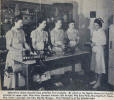 |
 |
|
Baptist Sugar 1952 |
Baptist
Stitch 1952 |
1927 Medical Assoc |
Nurse Lab Class |
Veterans Hospital 1930 |
|
| |
 |
 |
 |
 |
 |
|
St Joseph Mug |
James
Sanitarium 1890 |
Kennedy Matchbook |
Eye Ear Nose 1978 |
Medical Center 1950 |
|
| |
|
|
| |
|
|